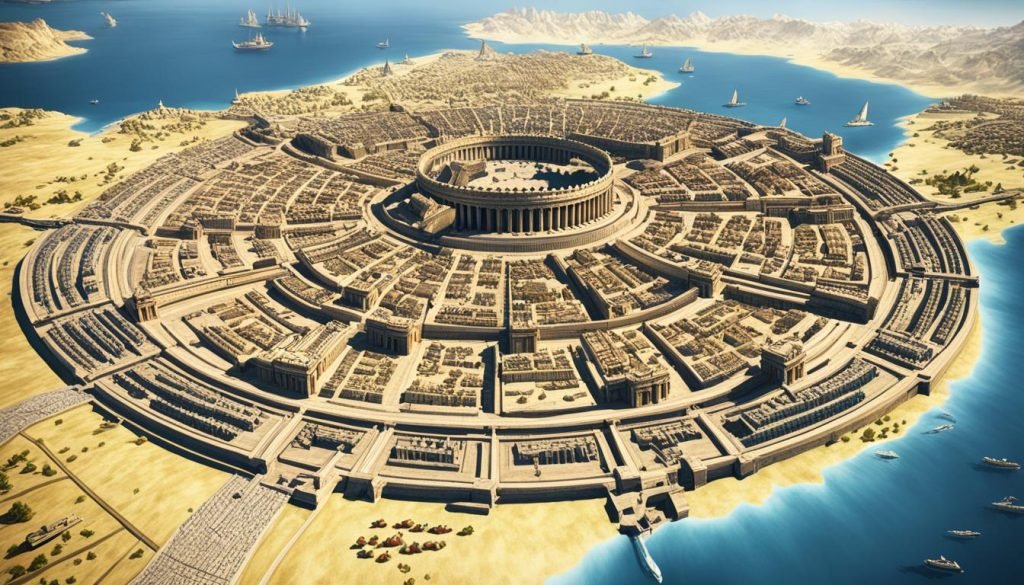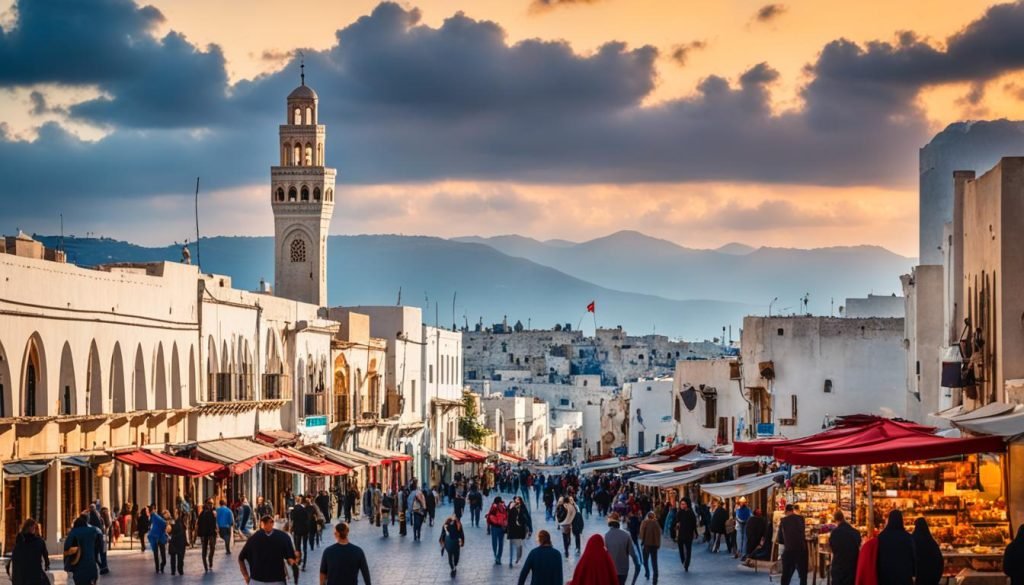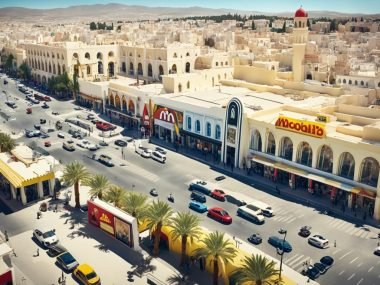Did you know Tunisia’s story began around 814 BC? That’s when the city of Carthage was founded. This event is a big part of Tunisia’s ancient roots. Over time, Tunisia grew and changed, touched by many different cultures and empires. The Phoenicians, Romans, Byzantines, Arabs, Ottomans, and the French all left their mark. Now, the Republic of Tunisia is at the top of Africa. It shows off a history filled with variety and change. Covering 163,610 km², it has 11.7 million people calling it home. Today’s Tunisia mixes its rich history with being able to change over time.
Key Takeaways
- Tunisia’s history dates back to 814 BC with the establishment of Carthage.
- Multiple civilisations including Phoenicians, Romans, and Arabs have influenced Tunisia’s historical timeline.
- The Republic of Tunisia is a testament to its diverse historical influences.
- Modern Tunisia spans 163,610 km² and has a population of 11.7 million.
- Tunisia’s resilient adaptability is showcased through its historical milestones from prehistoric times to the 21st century.
Introduction to Tunisia’s Rich Historical Background
The origin of Tunisia history starts with its first people, then Phoenicians making Carthage. These events shaped Tunisia’s modern self.
Tunisia’s history is full of big changes. Big moments include empires rising and falling. We see the start of Carthage, the Romans coming, then the Byzantines.
Next, Arabs brought Islam, followed by Ottoman rule. Then the French came until Tunisia found its independence.
| Period | Significant Events |
|---|---|
| Pre-814 BC | Indigenous Berber populations |
| 814 BC | Establishment of Carthage by Phoenicians |
| 146 BC | Roman conquest |
| 527 AD | Byzantine rule |
| 670 AD | Islamic Arabisation begins |
| 1574 AD | Ottoman control established |
| 1881 AD | French colonial era starts |
| 1956 AD | Independence achieved |
The origin of Tunisia history has many layers. From ancient Carthage to now, each period adds to its story. Such rich history deserves our attention.
Prehistoric Tunisia: The Earliest Inhabitants
Tunisia’s history goes back to prehistoric times. It shows us how the earliest people lived and grew. Evidence found shows human activity from almost 200,000 years ago. This was during the Stone Age.
Stone Age Discoveries
Many stone tools have been found near Kelibia. These tools tell us about the ancient Tunisians’ lives and skills. They were made with great care. This shows early humans were very clever and resourceful.
The Capsian Culture
The Capsian culture started between 10,000 and 6,000 BC. It was a key time in Tunisia’s history. These early people were good at farming and herding. This started the path for future societies.
They left behind many artefacts and figurines. These show they were a clever society. They were good at farming and lived in one place.
Phoenician Influence and the Founding of Carthage
The Phoenicians started changing Tunisia from the 12th century BC. Coming from the eastern Mediterranean, they sailed west. They made new homes along North Africa’s coast.
Arrival of the Phoenicians
Once the Phoenicians arrived, Tunisia began to thrive. They were excellent sailors and traders. Soon, their coastal homes grew into lively centres of trade.
Establishment of Carthage
By the 9th century BC, Carthage was thriving. It was well-placed on the Mediterranean for trading. Carthage became a big trade centre and a powerful city.
Carthage was a big moment for Tunisia. It showed the Phoenicians’ high hopes. The mix of Phoenician and local ways greatly changed Tunisia’s history.
| Milestones | Significance | Dates |
|---|---|---|
| Arrival of the Phoenicians | Introduction of maritime trade and culture | 12th century BC |
| Carthage Foundation | Rise as a major trade and power centre | 9th century BC |
Their impact on Tunisia is clear. From early settlements by Phoenicians to Carthage’s rise, each part shows an important time in Tunisia’s story.
How Old Is Tunisia History?
Tunisia has a rich history that started in 814 BC with Carthage. This city’s story shows how long Tunisia has connected with great civilisations. Their cultures and advancements uniquely shaped ancient Tunisia.
First, Tunisia was a busy trade centre for Phoenicians. Then, it flourished under the Romans, Byzantines, and others. These changes built a history full of stories and traditions. It shows how the past shaped today’s Tunisia.
Today, Tunisia is known as the Republic of Tunisia. Its story began with ancient Carthage and continues now. We can see the past in its ruins, traditions, and ways of life. This links Tunisia’s ancient roots to its present.
Carthaginian Empire: Power and Expansion

The Carthaginian Empire began with Phoenicians settling in Tunisia. It grew strong during the Punic Wars. This time had many important events for Tunisia.
Carthage had a great army and navy. It became a key power long ago. Its people were very tough, fighting hard in battles. They faced Rome and famous leaders like Hannibal.
- Expansion of Carthaginian trade routes
- Establishment of strategic colonies
- Naval supremacy in the Mediterranean
The Third Punic War was a big battle that led to Carthage’s sad end. Yet, the Carthaginian Empire has left a lasting impact. It helped shape culture and rule in the area.
| Key Event | Impact |
|---|---|
| First Punic War | Shift in Mediterranean naval power |
| Second Punic War | Hannibal’s legendary campaigns |
| Third Punic War | Destruction of Carthage |
Thinking about these events shows how big a mark the Carthaginian Empire left on Tunisia. It played a big role in the area’s history of major empires and key moments.
Roman Conquest and Occupation
The Romans took over Tunisia after beating Carthage in the Punic Wars. This changed Tunisia’s history a lot. Since 146 BC, Roman culture became a big part of Tunisia.
Punic Wars with Carthage
Rome and Carthage fought in the Punic Wars. These battles decided who ruled the Western Mediterranean. Carthage faced tough fights.
The final war destroyed Carthage. This led to Romans moving in.
Roman Legacy in Tunisia
The Romans improved Tunisia’s buildings, culture, and rules. They built big structures like amphitheatres and baths. We can still see these ruins today.
Roman roads helped trade and travel. This made the economy better.
| Aspect | Impact During Roman Occupation |
|---|---|
| Architecture | Construction of amphitheatres, baths, and temples. Iconic ruins like the El Jem amphitheatre stand as testaments. |
| Infrastructure | Development of extensive road networks that improved trade and mobility. |
| Governance | Implementation of Roman administrative systems, influencing local governance structures. |
| Cultural Influence | Introduction of Roman customs, language, and practices. |
Roman rule made a lasting mark on Tunisia. The country’s archaeological sites show this legacy.
Byzantine Rule and Vandal Invasion
After the Western Roman Empire fell, Tunisia faced big changes. The Byzantine period tried to keep Roman ways and culture. But, they were challenged by outsiders wanting to change the area.
Byzantine Administration
During this time, the Byzantines worked hard to fix and improve what the Romans left. They wanted to protect the area and were open to local traditions. This mix made a special time of rule focused on making the area stable and rich.
Vandal Control
The Byzantine’s stable time in Tunisia was stopped by the Vandals. This Germanic tribe took over after invading. They started the Vandal Kingdom, changing the area’s dynamics. Their rule was short but left a lasting impact on Tunisia’s history, showing how it was open to new changes.
Islamic Conquest and Arabisation
The 7th century AD was a turning point for Tunisia because of the Islamic conquest. This time started Tunisia Islamic history. Arab Muslims came and Islam spread widely. This led to the Arabisation of Tunisia.
Arab Muslim Arrival
Arab Muslims changed Tunisia’s culture and society greatly. They first came in 647 AD. They made Tunisia a key spot for Arab culture. This started a mix of Arab and Berber cultures in Tunisia Islamic history.
Spread of Islam
Arab leaders made Islam the main religion. Arabisation in Tunisia meant Arabic was the main language. It changed literature, art, and how government worked. Kairouan and Tunis became important places for Islamic learning and culture.
| Aspect | Impact of Islamic Conquest |
|---|---|
| Religion | Islam became the dominant faith, shaping everyday life and legal systems. |
| Language | Arabic replaced local tongues, embedding itself in culture and daily communication. |
| Urban Development | Key cities like Kairouan and Tunis flourished as hubs of learning and trade. |
The Rise of the Aghlabid and Fatimid Dynasties
The Aghlabid dynasty Tunisia was a time of wealth and progress. From 800 to 909 AD, the Aghlabids helped Tunisia grow. They built important Islamic sites and schools. This helped religion and learning thrive. The Great Mosque of Kairouan is one of their amazing works.
After the Aghlabids, came the Fatimid rule history. Starting in the 10th century, the Fatimids also helped Tunisia a lot. They made beautiful buildings and helped education and culture. They started the city of Mahdia in 921 AD. Their palaces and walls showed their skill and smart rule.
| Dynasty | Key Contributions | Notable Monuments |
|---|---|---|
| Aghlabid Dynasty |
|
Great Mosque of Kairouan |
| Fatimid Dynasty |
|
Mahdia Fortifications |
The Aghlabid dynasty Tunisia and Fatimid rule history changed Tunisia forever. They made Tunisia’s culture and buildings rich and great. Their work is a big part of Tunisia’s story, full of Islamic beauty and smart ideas.
The Almohad and Hafsid Influence
The Almohad and Hafsid dynasties shaped Tunisia’s history. They boosted the culture, politics, and economy. Their marks can be seen in today’s Tunisian society.
Control under the Almohads
In the 12th century, the Almohads took over Tunisia. This Berber Muslim dynasty was strict about Islam. They built many mosques, schools, and buildings that showed their beliefs and leadership.
The Hafsid Dynasty
The Hafsids followed the Almohads in the 13th century. They were a key part of Tunisia’s history. Under their rule, there was a bloom in arts, learning, and trade. The Hafsid Dynasty’s contribution included new trade routes. These routes connected Tunisia to the Mediterranean. This helped the economy grow and increased cultural exchanges. The Hafsids also supported education and the arts. This led to a cultural Golden Age that deeply influenced Tunisia.
Ottoman Empire’s Control over Tunisia
The Ottoman Empire took control of Tunisia in the 1500s. They brought in their own way of ruling but kept Tunisia’s freedom. This mix changed the local way of running things and defence.
Even with their power, the Ottomans let Tunisian dynasties grow. This mix of Tunisian and Ottoman ways created a special culture. Looking closer, we see how the Ottoman Empire influence on Tunisia changed its society and politics. It blended local traditions into the empire’s broader culture.
This time saw Tunisian and Ottoman rule live side by side. It made a place rich in culture and complex in politics. The survival of local rulers under Ottoman control shows a unique blend from this time.
The Ottoman impact changed many areas, like how things were run, military plans, and sharing cultures. Mixing local and Ottoman ways made Tunisia a diverse and changing place. This happened during the centuries the Ottomans were in charge.
| Aspect | Pre-Ottoman Era | Ottoman Era Influence |
|---|---|---|
| Administration | Native Dynasties | Ottoman Overlords with Local Autonomy |
| Military | Regional Forces | Strengthened by Ottoman Model |
| Culture | Local Traditions | Tunisian-Ottoman Synthesis |
The Ottoman Empire’s time in Tunisia changed administration and military strategies. This blending of influences created a unique culture and history. Its marks are still visible in Tunisia today.
French Colonial Era and Independence
In the late 1800s, French colonialism Tunisia started, changing the country a lot. The French Protectorate began in 1881. This brought big changes to how Tunisia was run and its money matters.
French Protectorate Establishment
The French Protectorate’s start led to major reforms in Tunisia. It changed the admin and financial sides to strengthen French power. The French put money into things like schools and roads, but it was mainly for their own good.
Struggle for Independence
After World War II, getting free from France was all Tunisia wanted. Leaders, like Habib Bourguiba, pushed everyone to ask for their own government. They did not stop fighting for this goal. Finally, on March 20, 1956, Tunisia became independent. This ended French control and started a new chapter for Tunisia.
| Year | Event |
|---|---|
| 1881 | Establishment of the French Protectorate |
| 1945 | Post-WWII nationalist movements emerge |
| 1954 | Negotiations for independence begin |
| 1956 | Independence achieved on March 20 |
Modern Tunisia: Post-Independence Developments
Tunisia has grown a lot since it became independent. Habib Bourguiba was the first president. He made the country more modern and focused on everyone being equal. The rule of Zine El Abidine Ben Ali later brought tough times.
After 1956, Bourguiba made big changes. He made schooling and women’s rights important. Thanks to him, Tunisia’s hospitals and roads got a lot better. This helped the country grow strong.
Ben Ali came to power in 1987. He tried to make the economy better by introducing new policies. But his time in power was marked by corruption. This led to a lot of unhappy people, which resulted in him being removed from power in 2011.
Many good things have happened in Tunisia since it became independent:
- Education: School became free and a must for everyone, making more people able to read and write.
- Healthcare: More people could get medical help when they needed it.
- Infrastructure: Roads and buildings were updated, making it easier for people to get around and do business.
- Women’s rights: Laws were made better so women could have more chances to work and be part of society.
Here is a table showing some big changes in Tunisia:
| Aspect | Developments |
|---|---|
| Political Stability | Went from a tough government to a hopeful democracy after 2011. |
| Economic Policies | Moved from government control to more open policies, and now trying new things. |
| Social Reforms | New laws made education, health, and women’s rights better, modernising society. |
| Technological Advancement | New technology is being used in different ways, sparking creativity and new ideas. |
Tunisia has made a lot of progress but still keeps its traditions. This mix of new and old has helped Tunisia face big world challenges well. Its journey shows how a country can become modern while remembering its past.
The Impact of the Arab Spring on Tunisia
Tunisia is where the Arab Spring started. This movement changed many countries in the Arab world from late 2010 to early 2011. People were upset about not having jobs, corruption, and lack of freedom. This led to protests in Tunisia that changed the country’s politics a lot.
The Tunisian Revolution
On December 17, 2010, the Tunisian Revolution began. It started because Mohamed Bouazizi, a street seller, set himself on fire. His act led to protests against President Zine El Abidine Ben Ali’s government. Ben Ali left Tunisia on January 14, 2011, after 23 years in power. This event was very important and started the *Arab Spring Tunisia*.
Democratic Progress
After the revolution, Tunisia worked hard to become more democratic. They made a new constitution in January 2014. It focuses on freedom and divides government powers well. Because of this, there have been peaceful changes in leadership. This shows the *democratic progress in Tunisia*.
People around the world are watching Tunisia carefully. The country is trying to keep its democracy strong while solving other problems. Tunisia’s move from revolution to a stable state is very important. It gives hope and lessons for democracy in the area. This is part of the story of *Arab Spring Tunisia*.
Tunisia in the 21st Century
Tunisia has started a fresh chapter in the 21st century. It’s seen big economic and political progress. The country is full of promise, opening up to the world.

Economic Growth
Foreign investment and innovation have driven Tunisia’s economic growth. It uses its good location, talented people, and varied economy. These have helped bring in global businesses.
New industries have grown, boosting Tunisia’s GDP. Unemployment rates have also fallen. These are signs of Tunisia’s economic success in this century.
Economic experts praise Tunisia’s reforms, stating, “Tunisia’s progressive policies are a beacon for emerging economies in the region, illustrating a successful balance between tradition and modernisation.”
Political Landscape
Since the Arab Spring, Tunisia’s politics have greatly changed. It’s moving towards democracy. This makes it a leader in political progress in its region.
It has a multi-party system and holds regular democratic elections. This shows its dedication to political reform and stability. Today, Tunisia has a lively political scene. It focuses on people’s rights and improving governance.
Conclusion
Tunisia has a complex and rich history. It goes back to ancient times and cultures. This includes the Capsian culture and the mighty Carthaginian Empire.
There have been many important times in Tunisia’s past. These include when Phoenician traders started Carthage and when Islam spread. Each period, like the time of the Byzantines or the French rule, added to Tunisia’s culture.
Today, Tunisia is proud of its diverse history. It is moving forward by making changes in politics and economy. It holds on to its heritage while looking forward to new things. This shows the spirit of Tunisia: respecting its history while embracing the future.







